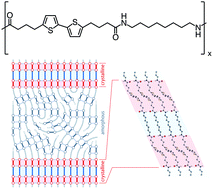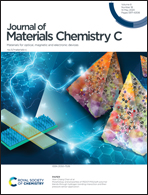Engineering polymers with improved charge transport properties from bithiophene-containing polyamides†
Abstract
Polymer semiconductors show unique combinations of mechanical and optoelectronic properties that strongly depend on their microstructure and morphology. Here, we have used a model π-conjugated bithiophene repeat unit to incorporate optoelectronic functionality into an aliphatic polyamide backbone by solution-phase polycondensation. Intermolecular hydrogen bonding between the amide groups ensured stable short-range order in the form of lamellar crystalline domains in the resulting semiaromatic polyamides, which could be processed from the melt and exhibited structural and thermomechanical characteristics comparable with those of existing engineering polyamides. At the same time, however, pulse-radiolysis time-resolved microwave conductivity measurements indicated charge carrier mobilities that were an order of magnitude greater than previously observed in bithiophene-based materials. Our results hence provide a convincing demonstration of the potential of amide hydrogen bonding interactions for obtaining unique combinations of mechanical and optoelectronic properties in thermoplastic polymers.



 Please wait while we load your content...
Please wait while we load your content...